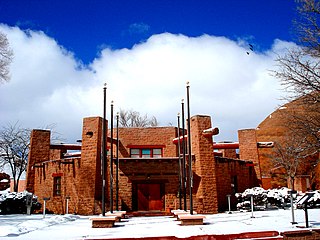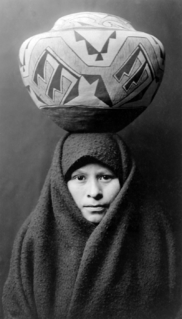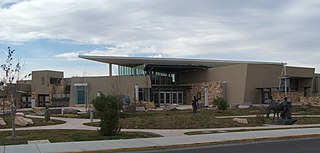
McKinley County is a county in the northwestern section of the U.S. state of New Mexico. As of the 2010 census, the population was 71,492. Its county seat is Gallup. The county was created in 1901 and named for President William McKinley.

Window Rock is a small city that serves as the seat of government and capital of the Navajo Nation, the largest territory of a sovereign Native American nation in North America. It lies within the boundaries of the St. Michaels Chapter, adjacent to the Arizona and New Mexico state line. Window Rock hosts the Navajo Nation governmental campus which contains the Navajo Nation Council, Navajo Nation Supreme Court, the offices of the Navajo Nation President and Vice President, and many Navajo government buildings.

Gallup is a city in McKinley County, New Mexico, United States, with a population of 21,678 as of the 2010 census. A substantial percentage of its population is Native American, with residents from the Navajo, Hopi, and Zuni tribes. Gallup is the county seat of McKinley County and the most populous city between Flagstaff and Albuquerque, along the historic U.S. Route 66.

Zuni Pueblo is a census-designated place (CDP) in McKinley County, New Mexico, United States. The population was 6,302 as of the 2010 Census. It is inhabited largely by members of the Zuni people.

The Zuni are Native American Pueblo peoples native to the Zuni River valley. The current day Zuni are a Federally recognized tribe and most live in the Pueblo of Zuni on the Zuni River, a tributary of the Little Colorado River, in western New Mexico, United States. The Pueblo of Zuni is 55 km (34 mi) south of Gallup, New Mexico. The Zuni tribe lived in multi level adobe houses. In addition to the reservation, the tribe owns trust lands in Catron County, New Mexico, and Apache County, Arizona. The Zuni call their homeland Halona Idiwan’a or Middle Place.

Zuni is a language of the Zuni people, indigenous to western New Mexico and eastern Arizona in the United States. It is spoken by around 9,500 people worldwide, especially in the vicinity of Zuni Pueblo, New Mexico, and much smaller numbers in parts of Arizona.

The Roman Catholic Diocese of Gallup is an ecclesiastical territory or diocese of the Roman Catholic Church in the southwestern region of the United States, encompassing counties in the states of Arizona and New Mexico and parts of Rio Arriba, Sandoval, Bernalillo, and Valencia Counties west of 106,52',41" meridian in New Mexico . The mother church is the Sacred Heart Cathedral in Gallup, New Mexico.

The Zuni (Zuñi) River is a tributary of the Little Colorado River in the southwestern United States. It has its origin in Cibola County, New Mexico, in the Zuñi Mountains at the Continental Divide. The river flows off the western slopes of the Zuñi Mountains in a generally southwesterly direction through the Zuni Indian Reservation to join the Little Colorado River in eastern Arizona. The Zuni River is approximately 90 miles (140 km) long, and has a drainage basin in New Mexico of approximately 1,300 square miles (3,400 km2).

Western New Mexico University is a public university located in Silver City, in the U.S. state of New Mexico. It has served the people of the state and its surrounding areas as a comprehensive, regional, rural, public coeducational university since 1893 and caters to a student body diverse in age, culture, language and ethnic background.

The Zuni Indian Reservation, also known as Pueblo of Zuni, is the homeland of the Zuni tribe of Native Americans.

The Zuni Mountains are a mountain range located mainly in Cibola County of northwestern New Mexico, with a small portion extending into McKinley County. The range is located largely in the Cibola National Forest, lying south of Interstate 40 from southeast of Gallup to southwest of Grants. The range is about sixty miles long and forty miles wide. The highest point is Mount Sedgwick, 9,256 feet ; elevations in the range go down to 6,400 feet.

The Albuquerque Museum, formerly known as The Albuquerque Museum of Art and History, is located in Albuquerque, New Mexico in Old Town Albuquerque. The Albuquerque Museum is dedicated to preserving the art of the American Southwest and the history of Albuquerque and the Middle Rio Grande Valley of New Mexico. The museum also contributes significantly to the cultural and educational programs in the city of Albuquerque. The museum features art of the Southwest and its global influences, as well as 400 years of Albuquerque history with permanent installations and special exhibitions of national and international origin.

Gallup is an Amtrak train station at 201 East Highway 66 in downtown Gallup, New Mexico. It is the second busiest station in the state, with more than 16,000 boardings and alightings in 2014.

The Arizona Museum of Natural History is the only natural history museum in the greater Phoenix area and is located in Mesa, Arizona. It exhibits the natural and cultural history of the Southwestern United States.

The Poeh Museum is a museum in Pojoaque, New Mexico, U.S.A. The museum is located off U.S. Route 84. It is devoted to the arts and culture of the Puebloan peoples, especially the Tewas in the northern part of the state. It was founded by Pojoaque Pueblo in 1987, and is housed in the Poeh Center. The museum organizes changing exhibitions, and is a large repository of permanent artifacts and programs. The museum has run the Oral Histories Documentation, which is part of the Museum's records, which involved participation of 38 Tewa elders providing stories about their lives; the information is available in both Tewa and English.

Robin Boast is the Professor of Information Science and Culture at the University of Amsterdam, Department of Media Studies. Until the end of 2012 he was the Deputy Director and Curator for World Archaeology at the Museum of Archaeology and Anthropology at the University of Cambridge. He teaches on Cultural Information Science, Neo-colonial information governance, and the history and sociology of digitally and collecting. He has been a Visiting Professor at the European University Institute in Florence Italy, a Scientific Advisor for several EU projects, and was the Director of the Virtual Teaching Collection Project. Dr. Boast has worked in museums in the US and Britain for over 30 years, specializing in museum access, classification and documentation, especially around diverse knowledge communities. Through a program of historical, theoretical and practical inquiry, his research explores forms of informed, collaborative and critical access to museum spaces and collections. Dr. Boast is currently working with many indigenous communities around the world that seek to enable and re-centre the many dimensions of local knowledge expertise within the academy – research informed by the critiques of the Sociology of Scientific Knowledge, Post-colonial studies, Indigenous Studies and collaborative developments in e-Science. Dr. Boast has worked for several years on an international research project which subjects the museum and the academy to the ethnographic gaze of indigenous partners to de-centre the ownership and control of research of indigenous patrimony. Prof. Boast has worked with source community museums and heritage organizations with Dr. Ramesh Srinivasan and Mr. James Enote, primarily at the A:shiwi A:wan Museum & Heritage Center in Zuni, New Mexico (USA). Most recently, Prof. Boast has been involved with repatriation and archiving projects with the Office of Indigenous Strategy and Engagement, Flinders University. His resent book projects include The Machine in the Ghost: Digitality and its Consequences, as well as an ongoing book project on Digital Information.
Harrison Begay was a renowned Navajo painter, perhaps the most famous of his generation. Begay specialized in watercolors and silkscreen prints. He was the last living former student of Dorothy Dunn at the Santa Fe Indian School. His work won multiple awards and is exhibited in museums and private collections worldwide.

The Pueblo IV Period was the fourth period of ancient pueblo life in the American Southwest. At the end of prior Pueblo III Period, Ancestral Puebloans living in the Colorado and Utah regions abandoned their settlements and migrated south to the Pecos River and Rio Grande valleys. As a result, pueblos in those areas saw a significant increase in total population.

Art of the American Southwest is the visual arts of the Southwestern United States. This region encompasses Arizona, New Mexico, and parts of California, Colorado, Nevada, Texas, and Utah. These arts include architecture, ceramics, drawing, filmmaking, painting, photography, sculpture, printmaking, and other media, ranging from the ancient past to the contemporary arts of the present day.

Iva Honyestewa is a Hopi/Navajo artist, social activist, and cultural practitioner. A Native American, Honyestewa is best known for her woven baskets and figurative sculpture. Honyestewa's most important breakthrough was the development of the pootsaya basket, called "a rare innovation in Hopi basketry". She developed the pootsaya during her 2014 residency at the School for Advanced Research in Santa Fe, New Mexico, having been awarded the Eric and Barbara Dookin Artist Fellowship.























